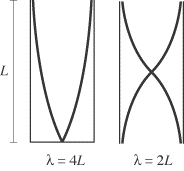The motion of a mass attached to a spring is given by Hooke’s Law,
F = –kx. Since the restoring force,
F, is directly proportional to the
mass’s displacement, x, a mass on a
spring does indeed exhibit simple harmonic motion.
There are two forces acting on a bouncy ball: the constant downward force of
mg, and the occasional elastic force
that sends the ball back into the air. Neither of these forces is proportional
to the ball’s displacement from any point, so, despite the fact that a bouncy
ball oscillates up and down, it does not exhibit simple harmonic motion.
Of the three examples given above, only a mass on a spring exhibits simple
harmonic motion, so the correct answer is B.
2. B
The frequency, speed, and wavelength of a wave are related by the formula
v =
?f.
Solving for
?,
we find:

3. B
The speed v of a wave traveling along a string of mass m, length
l, and tension T is given by:
 . This formula comes from the
relationship between v, T, and string
density m (namely,
. This formula comes from the
relationship between v, T, and string
density m (namely,
 )
combined with the fact that density
M = m/l.
Since velocity is inversely proportional to the square root of the mass, waves
on a string of quadrupled mass will be traveling half as fast.
)
combined with the fact that density
M = m/l.
Since velocity is inversely proportional to the square root of the mass, waves
on a string of quadrupled mass will be traveling half as fast.
4. D
The frequency of the beats produced by two dissonant sounds is simply the
difference between the two frequencies. In this case, the piano tuner will hear
beats with a frequency of 250 Hz – 200 Hz = 50
Hz.
5. B
A tube closed at one end can support a standing wave with a node at the closed
end and an antinode at the open end. A tube open at both ends can support a
standing wave with antinodes at both ends.

As the figure shows, the wavelength for a standing wave in a tube closed at one
end is twice the wavelength for a standing wave in a tube open at both ends.
Since frequency is inversely proportional to wavelength, the frequency for a
standing wave in a tube closed at one end is half the frequency of a standing
wave in a tube open at both ends.
6. E
When two waves move toward one another, they pass through each other without one
affecting the other. While both waves are in the same place, they will
superimpose to form a single wave that is the sum of the two waves, but once
they have passed one another, they will continue on their trajectory unaffected.
7. A
The easiest way to solve this problem is through simple intuition. When you
tighten a string, it plays at a higher pitch, and when you loosen a string, it
plays at a lower pitch. Pitch and frequency are the same thing, so in order to
raise the pitch of the piano string, the tuner has to tighten the string,
thereby raising its fundamental frequency.
8. A
In general, the frequency heard by the person is given by the formula:

where
ƒd
and
vd
are the frequency heard by the person and the velocity of the person,
respectively, and
ƒs
and
vs
are the frequency and the velocity of the police siren, respectively. Since the
police car is traveling toward the person, the person will hear a higher
frequency than that which the siren actually produces, so
ƒd
>
ƒs.
We also know that
vd
= 0. If
ƒd
>
ƒs,
then the fraction in the equation above must be greater than one, so the
denominator should read v –
vs,
and not v +
vs.
The resulting formula is:

9. C
Wavelength is related to velocity and frequency by the formula
?
= v/f. In the previous question, we
determined the frequency produced by the siren, so we can simply plug this
formula into the formula for wavelength:

10. D
Generally speaking, the frequency heard by an observer is the frequency emitted
at the source, multiplied by a factor of (vs - v0)/(vs - v), where
vs
is the speed of sound,
v0
is the velocity of the observer, and v
is the velocity of the source of the sound. Solving for
ƒ0,
the frequency heard by the observer, is just a matter of plugging the
appropriate numbers into the formula:

Common intuition should save you from answering A, B, or C:
when an ambulance moves toward you, its siren sounds higher than it actually is.
Back
Next
Next to display next topic in the chapter.
Practice Questions
Video Lessons and 10 Fully Explained Grand Tests
Large number of solved practice MCQ with explanations. Video Lessons and 10 Fully explained Grand/Full Tests.